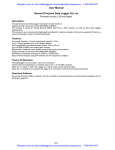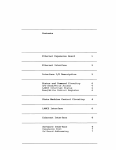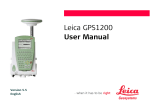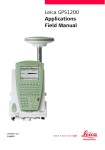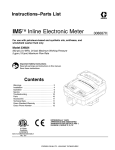Download GPS Datalogger User Manual Version 25b
Transcript
User Manual GPS Data Logger Firmware revision 2.5b and higher. Description: The GPS data logger is a small, robust product that records NMEA track data from a GPS. It is a convenient, economical alternative to using a laptop computer, especially on long road, 4WD and hiking trips. Simply connect the logger to your GPS during your trip, and then download the track-log to your PC for use with Ozi Explorer or similar software. Features: Stores up to 540,000 track-log points (DGPS-XM4). Non-volatile memory preserves data for up to 10 years. Economical 9V Alkaline battery Lightweight - suitable for hiking, cycling. Reads NMEA data from GPS. Selectable sample rate: NMEA data rate, or Programmable. Memory saving Automatic Log function. Programmable 4-character Identification. Downloads data to your PC in ASCII format. Easy to use Windows based download software. Ozi Explorer Track File support Ozi Explorer Event File Support Ozi Explorer Waypoint File Support Garmin PCX5 file support Waypoint+ file support GPS Exchange (GPX) file support Download Software: The Download software is a windows-based utility. It is easy to use and allows you to follow a step-bystep process for downloading and converting your data files. To install the download software, place the mini-cd into your cd-rom drive, making sure it is correctly located in the 8-cm recess of the drawer. Select “Install DataLogger Software” from the menu. If the menu does not appear automatically, go to start/run and type D:\setup.exe where D: is your cd-rom drive. Ensure that no other applications are running while you install this software. Shared files may not install correctly if other applications are running during the Install process. Several options can be selected using the ‘file-properties’ menu prior to downloading from the logger. Your chosen options will be recalled next time you use Datalogger Download. If errors occur during download, try reducing the download speed in the ‘file-properties’ menu. Page 1 Event Button: (on outside of case, if fitted) Press this button to store time and date in ‘Normal’ (no timestamp) logging mode. Useful as an Event button. Will save position and time data regardless of the DIP switch settings. The Download Software can save Event Button presses in separate Ozi Explorer Event and Waypoint files if required. During data download, pressing the event button will cancel the download. This may be useful in the event of computer malfunction. Data stored in the logger will not be lost. Pushbuttons: (inside battery compartment) Press BOTH buttons at once to reset the logger and clear all memory. Press EITHER button to store timecode data in ‘Normal’ (no timestamp) logging mode. This is the same as pressing the Event button. DIP Switches: (inside battery compartment) Use these switches to enable memory saving and data logging options. DIP switches may be changed ‘on the fly’ while the datalogger is operating. Helpful Tip: You can use a corner of the battery compartment lid to operate the DIP switches. DIP switch 1: Speed Check Switch ON to activate Speed Check. In this mode, the logger will not save at speeds below 3 knots (5.5Km/h). This reduces ‘rats-nest’ (due to position drift) when the GPS is stationary. Results in significantly cleaner track-logs and saves memory. Good for vehicle-based use. Switch OFF to log at any speed including zero knots. Good for walkers or boats. DIP Switch 2: Automatic Save Switch ON to activate Automatic Memory Save. This intelligent feature greatly reduces memory usage with minimal loss of track detail. You may want to experiment with this feature to find out if it suits your requirements. DIP switch 1 has higher priority than this switch. Therefore if DIP switch 1 is ON, speed must be higher than 3 knots before data will be saved. DIP Switch 3: Timed Save Switch ON to log pre-set intervals. (Default 10 seconds) Saves memory. Switch OFF to log every valid RMC sentence. DIP switches 1 & 2 have higher priority than this switch. If either or both are ON, conditions for those switches must be met before timed save will occur. If conditions are met during the preset time, data will be saved at the end of the pre-set time. DIP Switch 4: Normal/Date/Altitude Save Switch ON to save position PLUS time and date. (Uses more memory) Switch OFF to save position data only. (Normal mode saves memory) Also see the Event button. Page 2 DIP Switch Settings: Here are some recommended DIP switch settings for various activities: Switch 1 Speed Switch 2 Auto Switch 3 Timer Switch 4 Timestamp ON OFF OFF ON OFF ON ON ON ON ON OFF ON OFF ON ON OFF OFF ON OFF OFF OFF OFF ON OFF Best track detail Best Memory Life As Supplied OFF OFF OFF ON Best track detail Vehicle Walking Row Boat Boat >4 knots Mapping Long Trip GPS set-up: Ensure that your GPS data output is set to NMEA 0183 (2.0 or higher), 4800 baud. Enable the $GPRMC data word if this option exists (Some Magellan units) Enable the $GPGGA data word if this option exists (Some Magellan units) and you are using the DGPS-XM-ALT model. Insert the battery and connect the logger to your GPS. The LED will flash if valid data is being received from the GPS Battery Installation: Stored data will not be lost if battery is disconnected. Use a 9 volt alkaline battery, type MN1604, PC1604, 522, 6LR61 or equivalent. Open the battery compartment by gently pressing and sliding the battery cover towards the edge of the case. Attach the battery clip to the battery. Place the battery in the battery compartment. Ensure that the battery clip wires are clear of the DIP switches and push buttons. External Power: External power between 10V and 30V dc can be applied to pin 9 of the data connector. The 9V battery may be safely left in place when external power is applied. The 9V battery will not be discharged when external power is applied. Page 3 LED Indicator: The LED indicator flashes when data is received. The number of flashes gives you information about logger status: ONE flash: TWO flashes: THREE flashes: FOUR flashes: FIVE flashes: ON constant: ONE LONG Flash: Data has been received. Data has been received and saved. Data has been received and battery is low. Data has been received and memory is more than 88% full. Data has been received and memory is full. New data will not be saved; existing data will be protected. Download in progress. Invalid NMEA data received. Most likely the GPS has not locked-on to satellites. Note: The LED will only flash if data is received. This is because the logger goes into power-save mode if there is no data, in order to improve battery life and protect stored data. DB9 to 4-wire Cable: A DB9 to 4-wire cable, if supplied, can be wired to various GPS receivers and cables. The connections are below: Black: Pin 5 Red: Pin 9 Green: Pin 2 Yellow: Pin 3 Ground External Power 10V to 30V dc. Receive Data (From GPS) Transmit Data (To PC) Logger to PC Cable: The logger to PC cable is used to download data from the logger to your PC, and is basically a serial lap-link (null-modem) cable. Either end of the cable may be connected to the logger or PC serial port. Garmin 12XL Power/data cable: (option) This cable has three connectors: Garmin Round 4-pin GPS plug, DB9 Logger connector and car lighter socket plug. Voltage applied to the lighter plug will be supplied to both the GPS and the datalogger. WARNING: Some Garmin GPS units are not rated for more than 8V power. You must ensure that your GPS can handle the supplied DC voltage before using this cable. Garmin GPS12 Power/data cable: (option) This cable has three connectors: Round 5-pin GPS plug, DB9 Logger connector and car lighter socket adapter. 7 volts will be supplied to the GPS12, voltage applied to the lighter plug will be supplied to the datalogger. Garmin eTrex/eMap Power/data cable: (option) This cable has three connectors: eTrex GPS plug, DB9 Logger connector and car lighter socket adapter. 3 volts will be supplied to the eTrex, voltage applied to the lighter plug will be supplied to the datalogger. Map Datums NOTE: The NMEA position data sent by Garmin GPS units follows the map datum selected in the navigation setup menu. It is important that you set your GPS map datum to the same datum as you will use with your mapping software. WGS84 is recommended. Page 4 Specifications: Storage Modes/capacities: DGPS-xx, SRVY-xx Uses NMEA RMC sentence NORMAL: Store Latitude and Longitude only, DGPS-XM2 270,000-point capacity DGPS-XM4 540,000-point capacity SRVY-XM2 240,200-point capacity SRVY-XM4 480,400-point capacity TIMESTAMP: Store Latitude, Longitude, Time (UTC), Date DGPS-XM2 196,500-point capacity DGPS-XM4 393,000-point capacity SRVY-XM2 180,100-point capacity SRVY-XM4 360,300-point capacity DGPS-xx-ALT, SRVY-xx-ALT Uses NMEA RMC and GGA sentences NORMAL: Same as DGPS-xx, SRVY-xx Timestamp mode ALTITUDE: Store Latitude, Longitude, Time (UTC), Date, Altitude DGPS-XM2-ALT 166,300-point capacity DGPS-XM4-ALT 332,000-point capacity SRVY-XM2-ALT 154,400-point capacity SRVY-XM4-ALT 308,800-point capacity Altitude 00000 to 19999 metres When memory is FULL, new data will not be stored: existing data will be protected. Indicator: High efficiency LED flashes when data is received. Electrical: External Voltage: Supply Current: Main Battery: Memory Backup: 10-32V DC. Active 1.2mA Avg Standby 50uA Avg 9V Alkaline type MN1604, PC1604, 522, 6LR61 or equivalent. Nonvolatile Memory, 10-years with no power. Interface: 9 pin male D connector for Data/Power. Pin 2: Receive Data (From GPS) Pin 3: Transmit Data (To PC) Pin 5: Common Ground Pin 9: External Power Input RS-232 serial data. Compatible with typical GPS 5V data output & PC COM ports. Page 5 Cables: DB9 to 4 wires, for connection to various GPS units, 1.5m length. DB9 to DB9 laplink cable, for connection to PC for downloading data. 1.5m length. Optional Garmin compatible power/data cables. Physical: Dimensions: 66 x 112 x 28 millimetres Weight: 160 grams including battery Colour: Light Grey Case Material: ABS Commands: The following command set may be used with a terminal program, or as a guide for writing your own datalogger communications software. All commands start with a “#”. #DLCSV/CR/LF Download all data in CSV format: Standard: CR/LF A(V),ddmm.mmm(m),N(S),dddmm.mmm(m),E(W) CR/LF EOT header, latitude, longitude Timecode: CR/LF A(Vav),ddmm.mmm(m),N(S),dddmm.mmm(m),E(W),hhmmss,ddmmyy CR/LF EOT header, latitude, longitude, time(UTC),date Altitude: CR/LF A(Vav),ddmm.mmm(m),N(S),dddmm.mmm(m),E(W),hhmmss,ddmmyy,,,aaaaa CR/LF EOT header, latitude, longitude, time(UTC),date, reserved, reserved, altitude Notes: A=Valid data sentence, GPS OK a=Valid data sentence, GPS OK, Event button pressed. V=First valid sentence after 1 or more invalid sentences. Indicate track gaps. v=As Above. Event button pressed. (m) in brackets = Data output from ‘SRVY’ models 1/10000 arcminute Send ESC to cancel download Press Event button to cancel download Timecode and Standard data may be sent in the same download. Page 6 #DLCLR/CR/LF CLEAR memory and reset logger Logger returns CR/LF EOT #DLINF/CR/LF Data Logger INFormation will return: CR/LF DL-xx xxxx-xx CR/LF Where xx = model number n.n CR/LF n.n = software revision #DLBR0/CR/LF #DLBR3/CR/LF #DLBR5/CR/LF #DLBR6/CR/LF Set 4800 download Baud Rate Set 38400 download Baud Rate Set 57600 download Baud Rate Set 115200 download Baud Rate Logger returns SETxxx<CR><LF><EOT> at previous baud rate before changing. xxx = 048 = 4800 baud xxx = 384 = 38400 baud xxx = 576 = 57600 baud xxx = 115 = 115200 baud IMPORTANT: Returns to 4800 baud before using with GPS Power-up/reset/wakeup default = 4800bps Logger returns to 4800 baud after download. Logger returns to 4800 baud after 15 minutes of inactivity. #DLSTx/CR/LF Set Save Time interval – Default 10 seconds Enabled by setting DIP switch 3 ON DIP 3 OFF – NMEA rate DIP 3 ON – Selected rate #DLST0/CR/LF Set 5 second save interval #DLST1/CR/LF Set 10 second save interval (default) #DLST2/CR/LF Set 30 second save interval #DLST3/CR/LF Set 1 minute save interval #DLST4/CR/LF Set 2 minute save interval #DLST5/CR/LF Set 5 minute save interval #DLST6/CR/LF Set 10 minute save interval #DLST7/CR/LF Set 15 minute save interval #DLST8/CR/LF Set 15 second save interval (Added 2.3o) #DLST9/CR/LF Set 20 second save interval (Added 2.3o) Logger returns CR/LF EOT #DLIxxxx/CR/LF Set logger Identification 0000 to 9999, aaaa to zzzz Identification will be displayed on 1st line of CSV file, with an “I” header, eg “I,1234”. As supplied, Identification is 0000 If first character is set to ‘?’ eg ?234, the “I” line will not be sent. Notes: 1) The same data may be downloaded more than once. Data is not cleared at the end of a download. 2) User may download data and then continue logging from GPS. New NMEA data will be appended to the existing stored data. 3) All commands must be followed by a CR to begin execution. 4) The logger will send a CR/LF at the beginning of each transmission. This prevents overtyping the command string if a terminal package is used. 5) EOT = 04h Page 7 Warranty: This product is warranted to be free from defects in materials and workmanship for 90 days from the date of purchase. The manufacturer will, at its sole option, repair or replace any components that fail under normal usage during this period. The Customer is, however, responsible for any transportation costs. This warranty does not cover failures due to abuse, misuse, accident, tampering or unauthorised alteration or repairs. In no event shall the manufacturer be liable for any direct, indirect or consequential damages, whether resulting from the use, misuse, or inability to use this product, or from defects in the product. FCC Statement: This device complies with part 15 of the FCC rules. Operation is subject to the following two conditions: (1) This device may not cause harmful interference, and (2) this device must accept any interference received, including interference that may cause undesired operation. Notes: Due to ongoing product development and improvement, this user manual and specification is subject to change without notice. “Garmin” is a registered trademark of Garmin Corporation. “Magellan” is a registered trademark of Magellan Corporation. Supplied By: Copyright © Robert I Keskull 1999-2006 Page 8

















